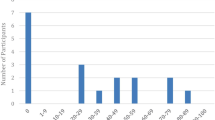Abstract
The opportunity for library users to design and execute their own database searches through direct access to computerized data sources is known as end-user searching. Due to the proliferation of microcomputers and changes in software design, the phenomenon is gaining widespread support among libraries across the country. This paper describes three methods of education and training-course-integrated, classroombased and self-service. The role of the librarian is identified in each.
Similar content being viewed by others
References
Ahmad, C. F. (1986).Bibliographic instruction in ARL Libraries. SPEC Flyer 121. Washington, D.C.: Association of Research Libraries.
Antony, A., Silvers, R., Weiser, V., and Hodina, A. (1978). An on-line component in an interdisciplinary course on information resources for science and engineering students,Online Review, 2, 337–341.
Bayer, B. and Schwerzel, S. W. (1982). A comparison of on-line and manual searching in selected areas of research. InProceedings of the National On-line Meeting (pp. 23–27), Medford, N.J.: Learned information.
Branch, K. (personal communication February 23, 1984).
Buntrock, R. E. and Valicenti, A. K. (1985). End-users and chemical information.Journal of Chemical Information and Computer Sciences, 25, 203–207.
Fjalbrant, N., Kihlen, E., and Malmgren, M. (1983). End-user training in the use of a small Swedish database.College and Research Libraries, 44, 161–167.
Janke, R. V. (1984). On-line after six: end user searching comes of age.On-line, 15–29.
Krueger, G. L. and Des Chene, D. (1980). Introducing on-line information retrieval to the undergraduate and graduate students in chemistry.Journal of Chemical Education, 57, 457.
Lee, B. (1985). Faculty involvement in enhancing student learning,Academe, 71, 22–25.
Lucia, J. and Roysdon, C. (1984). On-line searching as an education technology: Teaching computer wise and end-users. InProceedings of the National On-line Meeting (pp. 187–194). Medford N.J.: Learned Information.
Norris, C. (1986). On-line micros: end-user training. InProceedings of the Small Computers in Libraries Software/Computer Conference and Exposition for Information Managers and Librarians (pp. 341). Westport, CT: Meckler Publishing Company.
Quint, B. (1985). Question: what's an end-user?Database End-User, 1, 3.
Riles, W. (1976 July 4). The next 100 years—education,San Francisco Chronicle, section A, p. 3.
Ward, S. N. and Osegueda, L. M. (1984). Teaching university student end-users about online searching.Science and Technology Libraries, 5, 17–31.
Author information
Authors and Affiliations
Additional information
She also serves as the Coordinator of End-User Instruction for the library.
Rights and permissions
About this article
Cite this article
Rockman, I.F. End-user bibliographic instruction: A new approach to retrieving knowledge. Innov High Educ 12, 10–15 (1987). https://doi.org/10.1007/BF00892443
Issue Date:
DOI: https://doi.org/10.1007/BF00892443




